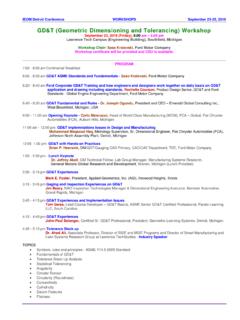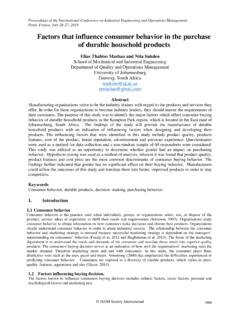Transcription of The Role of Total Quality Management (TQM) Practices on …
1 Proceedings of the International Conference on Industrial Engineering and Operations Management Bogota, Colombia, October 25-26, 2017 The Role of Total Quality Management (TQM) Practices on Improving Organisational Performance in Manufacturing and Service Organisations. Nita Sukdeo Department of Quality and Operations Management University of Johannesburg Gauteng, South Africa 2001 Jan-Harm Pretorius and Andre Vermeulen School of Engineering Management University of Johannesburg Gauteng, South Africa 2001 Abstract Organisations in South Africa now, more than ever before, need to introduce Total Quality Management (TQM) in their organisational culture to provide outstanding products and services to their customers. Although TQM has been introduced to improve organisational performance, it is perceived that some organisations have not accomplished much over the years.
2 Achieving results by implementing TQM is challenging and depends on (i) leadership, (ii) employee involvement, (iii) customer focus, (iv) strategic planning, (v) supplier relations, (vi) process Management and (vii) information analysis. These principles must be incorporated in the organisational performance measures in terms of (i) Quality improvement, (ii) product/service Quality , (iii) customer satisfaction, (iv) employee satisfaction and (v) supplier performance. Current research in both the manufacturing and service industries in South Africa reveals that TQM does have an influence on the five organisational performance measures and plays an important role in the performance and success of an organisation. Keywords Total Quality Management , organisational performance, performance measure, customer satisfaction impact of global competition is forcing organisations to place greater emphasis on providing customers with high Quality products and services [Baloyi, 2013] [Dale, 1999] [Edosmwan, 2002].
3 Consequently, improving the Quality of products, processes and services is a major challenge facing South African organisations as well as organisations worldwide. Many organisations fail because they do not take cognisance of the long-term benefits of Total Quality Management (TQM) Practices . Organisations do not realise the value of integrating these Practices into their daily operations. Therefore, the following objectives have been developed for the study: a)To design and administer a questionnaire to determine the role and impact of Quality improvement, customersatisfaction, employee satisfaction, product/service Quality and supplier performance in the manufacturingand service organisations, which lead to organisational )To determine the relationship between TQM Practices and organisational performance by means ofhypothesis testing.
4 IEOM Society International 1133 Proceedings of the International Conference on Industrial Engineering and Operations Management Bogota, Colombia, October 25-26, 2017 In line with objective b) the following hypotheses were developed: H1: The TQM Practices are positively related to Quality improvement. H2: The TQM Practices are positively related to product/service Quality . H3: The TQM Practices are positively related to customer satisfaction. H4: The TQM Practices are positively related to employee satisfaction. H5: The TQM Practices are positively related to supplier performance. 2. Literature review Quality is extremely advantageous for every organisation today. Quality plays a significant role in the business environment of organisations as Quality and continuous Quality development guarantee an organisation s survival in a competitive environment.
5 [Evans, 2005] [Foster, 2007]. A plethora of studies have been undertaken on the role of TQM Practices in enhancing organisational performance in both manufacturing and service organisations. Some studies were undertaken in specific industries whilst others were comparative in nature. Brief reviews of some of the studies are presented below and selected TQM Practices are highlighted. Implementation of TQM in global organisations Chin, Tummala and Chan (2003) conducted a survey of the implementation of TQM Practices in the Hong Kong electronics and toy product organisations. These organisations were required to indicate the extent to which TQM Practices were being implemented and practiced. The five TQM Practices used in their study were (i) customer focus, (ii) leadership, (iii) strategic planning, (iv) activity based Management and (v) continuous improvement.
6 Their study established that both Hong Kong industries regarded customer focus as the most important TQM practice. Mady (2009) conducted a survey of the implementation of TQM in two Kuwaiti industrial sectors, namely food processing and refractors. The TQM Practices of (i) customer focus, (ii) employee involvement and (iii) core Quality Practices were used in their study. He found that these three TQM Practices were used in both industries to improve Quality . Arumugam, Ooi and Fong (2008) explored the relationship between TQM Practices and organisational performance in Malaysian manufacturing organisations. The TQM Practices identified in their study were (i) leadership, (ii) process Management , (iii) information analysis, (iv) customer focus, (v) supplier relations, (vi) Quality system improvement, (vii) continual improvement and (viii) employee involvement.
7 They found that a positive relationship existed between customer focus and organisational performance. Implementation of TQM in South African organisations Oschman, Stroh and Auriacombe (2006) studied the attitude of personnel at South African Air Force bases towards the implementation of TQM. They developed a framework consisting of six core Practices and eight supporting Practices . They found that the attitude of respondents in three out of the six core Practices (leadership, employee involvement and strategic planning) was very positive with respect to Quality improvements. With regard to the manufacturing sector, [Baloyi, 2013] [Tashakkori and Creswell, 2007] [Ceronio, 1996], identified the following TQM Practices as imperative to the implementation and success of TQM in manufacturing industries: (i) top Management commitment and (ii) communication, (iii) employee involvement through training, (iv) Quality strategy, (v) product Quality and (vi) customer satisfaction.
8 He highlighted these Practices as critical factors to enhancing organisational performance. Implementation of TQM in manufacturing and service industries In today s competitive business environment TQM has experienced a fundamental shift. The theory is no longer restricted to the manufacturing sector. It has now been extended to service sectors such as health care, education, hospitality and financial institutions, to name a few [Lakhe and Mohanty, 1995]. It has been identified and acknowledged the applicability of TQM for sustainable competitive advantage and especially highlighted its value for the service sector. The growth of the service industry has resulted in an increased focus on TQM in service organisations delivering high- Quality services to customers [Schneider and White, 2004] and [Talib, Rehman and Qureshi, 2013].
9 According to Gustafsson, A, Nilsson and Johnson (2003), studies were undertaken in the manufacturing sector and later spread to the service sector. Therefore, the study has endeavoured to include the service environment and draw a comparison with the manufacturing environment. 3. Research Framework The following research framework was followed. Studies were conducted using empirical hypotheses to test specific IEOM Society International 1134 Proceedings of the International Conference on Industrial Engineering and Operations Management Bogota, Colombia, October 25-26, 2017 TQM Practices such as leadership (top Management commitment), employee involvement (human resource Management ) or customer focus, to determine their effect on organisational performance.
10 Other Practices that were identified are: supplier relations, strategic planning, process Management and information analysis [Taylor and Wright, 2006]. A discussion on the evaluation of the importance of each of these Practices and their success as drivers of TQM are illustrated in Figure 1. Total Quality Management Practices : ORGANISATIONAL PERFORMANCE MEASURES: OVERALL ORGANISTIONAL PERFORMANCE Figure. 1 Research framework Leadership Gonzalea and Guillen (2002) agreed that Management commitment and leadership is one of the most important factors for the successful implementation of TQM. Leadership had to create and maintain an environment that required the involvement of all employees to achieve the Quality objectives of the organisation.










